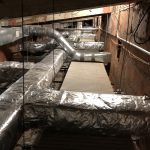What Does a WELL-Designed Building Look Like?
What is the WELL Building Standard™?
The WELL Building Standard™ (WELL™) acts as a map, creating a customizable path that leads building owners and designers to create a space that inspires healthier, more productive, and happier people. The U.S. Green Building Council (USGBC) explains this as, “a performance-based system for measuring, certifying, and monitoring features of the built environment that impact human health and wellbeing, through air, water, nourishment, light, fitness, comfort, and mind.”[1]
In other words, WELL projects implement measures, based on the seven areas above, in building design and tracks the results to confirm that the measures taken actually result in positive change. These measures help buildings become an extension of a person’s environment, rather than simply a structure.
For a more in-depth explanation of the WELL Building Standard and the benefits of a WELL building, read “What is the WELL Building Standard?”
What does a building designed to the WELL Building Standard look like?
The commercial office space at 1201 Cass Street in Omaha, Nebraska, now serving as the headquarters for Alvine and Alvine, is a prime example of a facility built to WELL standards. WELL Certified™ Gold, 1201 Cass features a variety of innovative solutions to meet the strict WELL requirements, while providing optimal office space.
The value of WELL was recognized from the start. “A WELL-designed space puts the emphasis on how the users will function and feel, increasing productivity, satisfaction, and enjoyment of the work environment,” explains Brandon Rich, P.E., LEED AP BD+C, WELL AP, Fitwel Ambassador, and project manager for the 1201 Cass project. “Designing a space to these standards is something everyone benefits from.”
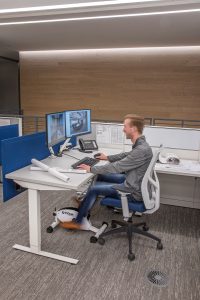
The mechanical systems were designed to provide even more occupant comfort than typical office systems. The underfloor air distribution systems used throughout the office allow each workstation to have control of the airflow at each desk. Users can open or close the diffuser to release more or less cool air from the supply plenum to circulate around them. Another benefit of underfloor air is the single path for the air. The air comes out of the floor plenum, occupants breath the air, and then it travels up to the ceiling where it is returned to the air handler and filtered again prior to making another pass through the system. This, along with activated carbon filtration, provides high quality air for the users of the space and decreases the chances of transmitting illness.
Encouraging hydration is one of the main focuses of the WELL system, which is why anyone walking through the office might notice a hydration station located within 100 feet of all regular work stations. The building is water-conscious in a variety of other ways, too, especially in the dining areas. One WELL feature requires people to have the option to bring their own lunch and wash their dishes. To make this as easy for users as possible, the design team chose commercial under-counter style dishwashers that use less than one gallon of water per 90-second cycle, while cleaning and sanitizing with a 180 degree rinse. For comparison, a residential style dishwasher will use three gallons of water during a two-hour cycle.
To promote a healthy circadian rhythm, daylighting provided by the curtainwall is balanced with color temperature from the electric light fixtures. The LED lighting and motorized window shades are controlled by photocells. The shade controls follow a two-step process: first, they use window height, latitude, longitude, façade, and work surface distance from the window to create a consistent schedule; then, sensors attached to the window façade allow for override to prevent any desk from experiencing direct light. The lighting system is programmed to adjust the color temperature of the electric light fixtures from sunrise to sunset, blending cohesively with the daylight. These measures keep the light within the space from straining occupants’ eyes and reinforce circadian rhythms.
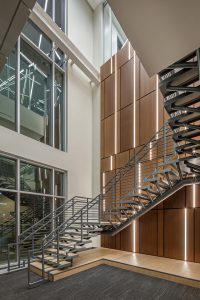 Wayfinding through specific light fixtures is one of the strategies used by the design team to encourage better physical health. In general, wayfinding utilizes building fixtures or architecture to subliminally guide a person through the space. Wayfinding is used in the entry at 1201 Cass, where linear fixtures are mounted vertically within the acoustic wood paneling, immediately catching visitors’ attention and guiding them up the stairs, rather than to the elevator. Not only is this a health benefit to the users, but also an environmental benefit, as the less the elevator is used, the more energy that is saved. Once upstairs, a continuous recessed line of light running along the floor, then up the walls, serves as a visible marker of the suggested route to the upper level by the central circulation stair.
Wayfinding through specific light fixtures is one of the strategies used by the design team to encourage better physical health. In general, wayfinding utilizes building fixtures or architecture to subliminally guide a person through the space. Wayfinding is used in the entry at 1201 Cass, where linear fixtures are mounted vertically within the acoustic wood paneling, immediately catching visitors’ attention and guiding them up the stairs, rather than to the elevator. Not only is this a health benefit to the users, but also an environmental benefit, as the less the elevator is used, the more energy that is saved. Once upstairs, a continuous recessed line of light running along the floor, then up the walls, serves as a visible marker of the suggested route to the upper level by the central circulation stair.
Positive mental health benefits can result from better physical health and, through biophilia, so can a connection to the outdoors. Biophilia is the idea that humans seek interaction and association with nature and living organisms[2]. In a building, this can be incorporated by the use of wood which fosters a connection to nature or organic lighting that connects color and saturation to the outdoors like that used by the color-changing fixtures at the reception desk. These fixtures use a custom control scheme developed by Alvine’s lighting designers to adjust the Red, Green, Blue, and Amber LED values based on outside air temperature (blue at cooler temperatures ranging through 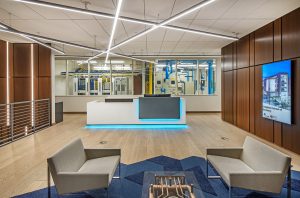 green and yellow to red at hot temperatures), and adjusts the dimming of the white based on wind speed (at lower wind speed, white is dimmed for more saturated color and increased for a less saturated color at higher wind speeds). Other mentally stimulating building features include an accessible patio and a green roof that also has environmental benefits such as native plants that use less water and filter storm water runoff.
green and yellow to red at hot temperatures), and adjusts the dimming of the white based on wind speed (at lower wind speed, white is dimmed for more saturated color and increased for a less saturated color at higher wind speeds). Other mentally stimulating building features include an accessible patio and a green roof that also has environmental benefits such as native plants that use less water and filter storm water runoff.
Are requirements limited to those seven categories?
Overall, WELL’s seven main categories provide a general outline of workplace wellness; however, there are many other opportunities for advancement. Acoustics, for instance, is another area where WELL standards help to establish a more comfortable and productive setting. To address these standards, the reverberation time, background noise, and sound transmission at 1201 Cass were all evaluated during design so that appropriate treatments and wall constructions could be incorporated to meet the requirements. Open office area acoustics were also evaluated to ensure acceptable work environments were provided for occupants and resulted in using high NRC ceiling tiles, as well as partitions of acceptable heights to limit speech transmission between cubicles.
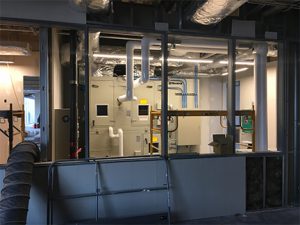 However, acoustical considerations were not limited to the open office. It was important to the building owner that visitors could see into the mechanical room from the front lobby. Mechanical equipment is loud by nature and a high traffic area like the lobby needs to be free of distracting noise. In order to properly isolate sound from the mechanical room while still providing visibility, a high performance window assembly was required.
However, acoustical considerations were not limited to the open office. It was important to the building owner that visitors could see into the mechanical room from the front lobby. Mechanical equipment is loud by nature and a high traffic area like the lobby needs to be free of distracting noise. In order to properly isolate sound from the mechanical room while still providing visibility, a high performance window assembly was required.
Unfortunately, acoustically-rated manufactured window assemblies come at a significant cost. To overcome this obstacle, the acoustical team provided the contractor with a custom installation that could be built and installed in the field to be more cost effective. To minimize the sound transmission to the lobby and provide the required rating, the team provided the glass types, the required air spacing, and appropriate seals for the installation.
Can I see WELL design for myself?
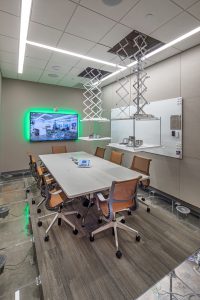 One of the goals of 1201 Cass was to create a living learning lab where engineering is on display for students, colleagues, and the community. Throughout the building, systems are exposed and available for demonstrations to visitors. In fact, over 100 tours of the space and systems have been given to visitors including architectural, engineering, student, and owner groups, many of whom have taken some of the concepts and used them in their own designs.
One of the goals of 1201 Cass was to create a living learning lab where engineering is on display for students, colleagues, and the community. Throughout the building, systems are exposed and available for demonstrations to visitors. In fact, over 100 tours of the space and systems have been given to visitors including architectural, engineering, student, and owner groups, many of whom have taken some of the concepts and used them in their own designs.
Walking up the stairs to the second-floor lobby, large viewing windows behind the reception desk allow visitors to see into the server and mechanical rooms. The ceiling was left exposed in one hallway to provide examples of the HVAC system and fireproofing. In one of the conference rooms, clear flooring shows off the underfloor air distribution system and the ceiling has the ability to change out light fixtures for demonstrations.
Where can I learn more?
To learn more about The WELL Building Standard, including requirements, certifications, and benefits, visit the International WELL Building Institute™ (IWBI™).
Read more about Alvine’s commitment to WELL as an IWBI Corporate Cornerstone Member.
To read testimonials on the positive impacts of a WELL building or the benefits of hiring a WELL Accredited Professional (WELL AP™), visit the article “What is the WELL Building Standard?”
To learn more about acoustical engineering, read the article “What is an Acoustical Consultant?” featured on the Alvine website.
Follow the links to learn more about Alvine or Alvine.
Bibliography
[1] Knox, N. (2015, April 2). What is WELL? Retrieved January 15, 2020 from U.S. Green Building Council: https://www.usgbc.org/articles/what-well
[2] Merriam Webster. (2019). Biophilia. Retrieved January 15, 2020, from Merriam Webster: https://www.merriam-webster.com/dictionary/biophilia




